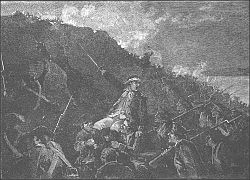Battle of Stony Point
| Battle of Stony Point | |||||||
|---|---|---|---|---|---|---|---|
| Part of the American Revolutionary War | |||||||
 Capture of Stony Point by Wayne |
|||||||
|
|||||||
| Belligerents | |||||||
|
|
|
||||||
| Commanders and leaders | |||||||
| Anthony Wayne | Henry Johnson (POW) | ||||||
| Strength | |||||||
| 1,500 | 750 | ||||||
| Casualties and losses | |||||||
| 15 killed 83 wounded |
20 killed 74 wounded prisoners 472 unwounded prisoners 58 missing |
||||||
Coordinates: 41°14′28″N 73°58′26″W / 41.241°N 73.974°W
The Battle of Stony Point took place on July 16, 1779, during the American Revolutionary War. In a well planned and executed nighttime attack, a highly trained select group of George Washington's Continental Army troops under the command of Brigadier General "Mad Anthony" Wayne defeated British troops in quick and daring assault on their outpost in Stony Point, New York, approximately 30 miles north of New York City.
The British suffered heavy losses in a battle that served as an important victory in terms of morale for the Continental Army. While the fort was ordered evacuated quickly after the battle by General Washington, this key crossing site was used later in the war by units of the Continental Army to cross the Hudson River on their way to victory over the British.
Following the surrender of General John Burgoyne after the Battles of Saratoga in October 1777 and the subsequent entry of France into the war as an American ally, British strategy in dealing with the rebellious Americans was forced to change. In the northern states, their strategy was reduced to raids against targets of economic and military importance, and unsuccessful attempts to bring Major General George Washington's Continental Army into a decisive confrontation. Washington deployed his army in strong positions around the principal British base at New York City, and refused to be drawn out of them.
...
Wikipedia
